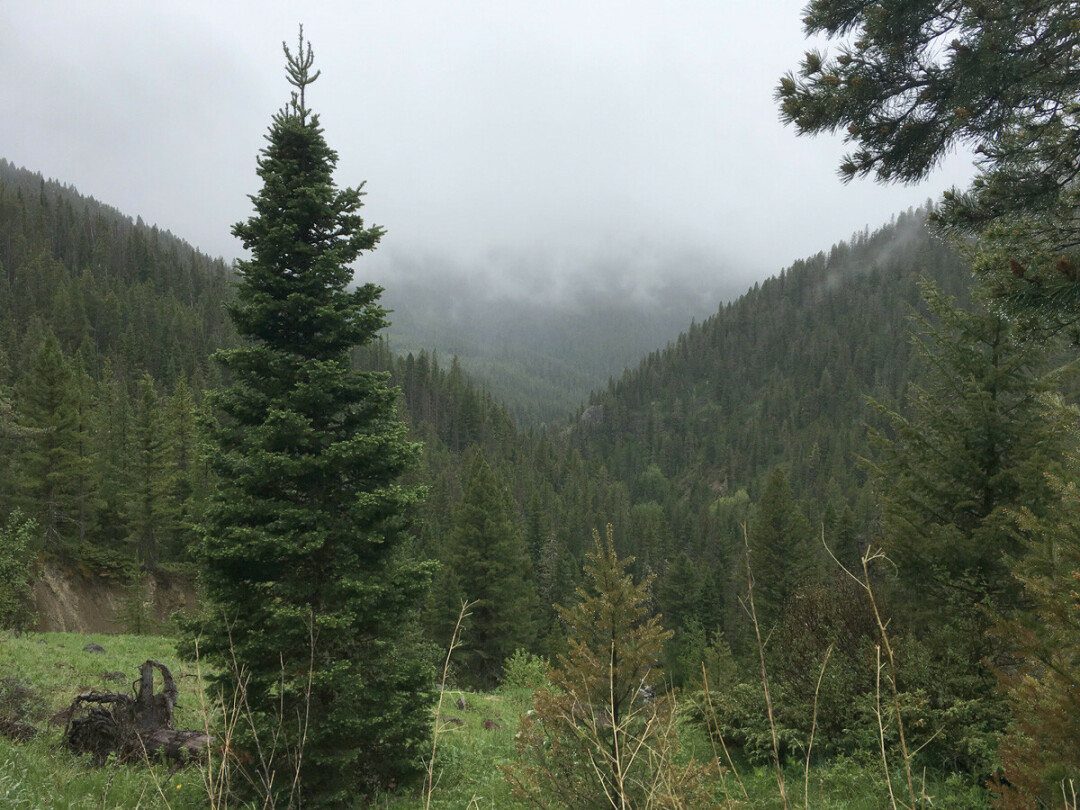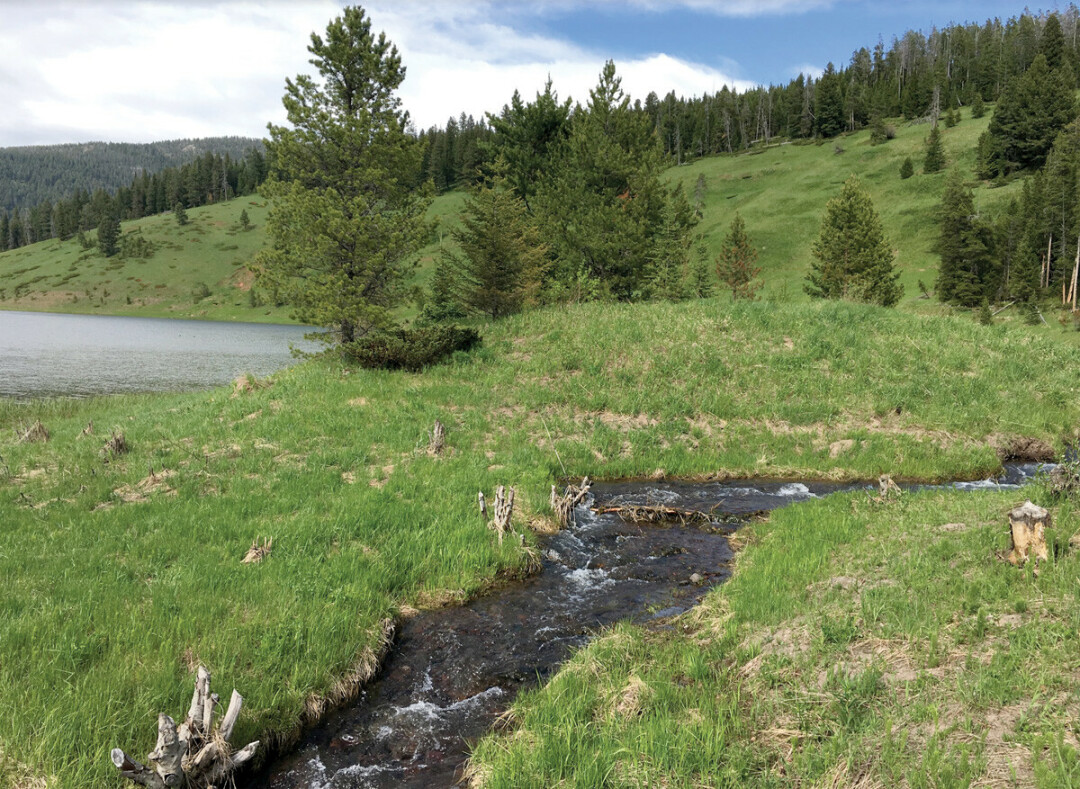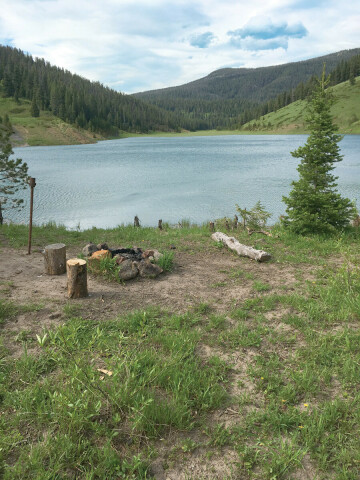Blazing Trails At Mystic Lake
Christopher Dyrland-Marquis | Thursday Jul. 1st, 2021

The foreboding, summer squall barrelled through the alpine valley, rippling the surface of Mystic Lake and buffeting grass and trees growing by the water’s edge with pockets of blustering wind. The afternoon before had been as perfect as ever, with blue skies and sunshine that illuminated the forested valley—a deep green grove of evergreen trees and vibrant grasses—but during the night the weather had soured, and a gloomy midday had introduced ominous skies.
Heavy raindrops began to bombard my campsite, soon rolling in sheets, pooling and soaking under the tarp I had slept beneath and pattering as they struck the billowing walls of my A-frame shelter. My bedroll was utterly soaked; the sleeping bag and ground cloth did little to defend against so much moisture, and began to wick up groundwater that trailed in. I paced outside—scrambling around in a previously-thought-to-be-weatherproof coat that had completely soaked through—shivering and dripping as I frantically packed up my campsite to start back down the 10 mile trailhead, praying that enough daylight remained for me to return. With my backpack fully filled, my campfire drowned, and the campsite cleaned, I pulled a dripping hood over my face, took a final glance at the sublime landscape that stretched out across the valley, and turned against the slashing rain falling around me to start back down the mountain.
Anyone who has ever experienced the worthwhile journey to Mystic Lake through the Bozeman Creek Trailhead is certain to have experienced some of the same emotions I felt after hiking it. The 10 mile pilgrimage leads along Bozeman Creek, which can be visible for a time, before the trail rises further into the Custer Gallatin National Forest: leading up increasingly steep and arduous paths that ultimately become choked by ancient, encroaching pines. On its final stretch, the road rises in several hairpin turns—often reversing directions—and curls sharply around steep ridges that drop far below. The scenery along the way seems taken straight out of a picturesque painting, with rugged cliffs of stone rising from the far side of valleys, and tunnels of evergreen trees towering above and climbing towards the sky. Even gentle hills of grass and wildflowers can be found along the trail, offering soft contrasts to the harsh mountains that surround them.
Whether you are one for company or one for solitude, the hike to Mystic Lake has both: as I climbed my first few miles, the path was comfortably filled with travelers on foot and on bicycles as well. Some walked with a partner, others jogged by themselves, and the occasional friendly dog would pass by. Farther up the trailhead as mile markers and elevation rose, a pleasant flow of pedestrians trickled away into individuals more dedicated to the climb (or stubborn in my case), and eventually thinned away into interactions with only the natural, ambient heart of the forest: the whispering and creaking of pine boughs, sharp chirps of chipmunks overhead, and occasional far-distant rumbles of unseen waterfalls or springs.
Bozeman Creek Trailhead is certainly not a hike you would want to do with heavy bags full of equipment, but it is almost required if you wish to stay at Mystic Lake for any amount of extended time. At a walking pace, with plenty of stops for drinking water, taking photos, and resting, the climb takes about half of a day. If travelers aren’t looking to camp overnight, there might be very little time to savor the lake itself before turning back. Additionally, if completed in one sitting, hikers will find themselves walking 20 miles in total, through elevated terrain and with no services—certainly a scenario that obligates prior safety considerations in the event of an injury or delay. Camping off of the trail is not a good idea either: violent wind storms frequently pass through the valley, and farther along Bozeman Creek Trailhead, widow makers—old, dead trees liable to fall over—commonly crash onto the forest floor and across the trail.
In spite of the potential hazards and safety precautions to consider before departing, the experiences to be found on the trailhead justify such an arduous adventure. Impressive natural features can frequently be seen as the hike progresses, including the watershed formed by Bozeman Creek, and the formidable ridges of Mt. Ellis that the trailhead wraps around. Occasionally, one or two springs last into the midsummer and provide a small respite of freshwater to refill depleted water bottles, though care should be taken to properly disinfect and sterilize it before drinking, as unclean water may harbor parasites or pathogens. But, most impactful, the view once you have arrived at the shore of Mystic Lake is utterly breathtaking: two ridges rise to each side of the lake, and sloping inclines lie dotted with evergreen trees and mountain grasses. Far behind the lake, a small tributary irrigates lush meadows that gently wrap around the valley and follow it, curving beyond and out of sight.
It’s easy to become discouraged while climbing the difficult trail, as the winding path seems to stretch on forever (and you admittedly find yourself anticipating encounters with the next sparsely placed mile marker), but experiencing such a magnificent, humbling valley open up before your very eyes makes the whole trip worth it. Several informal camping sites sit along the shore, offering fire pits and log stools to relax after the long journey and massage any blistered feet. At the gentle embankment I ultimately chose for the night, I observed a flock of sparrows swooping down towards the water’s surface to hunt insects. My grateful ears savored their melodious birdsong, echoing beyond the water and into the valley: floating across the cool, misted air.
Evenings at Mystic Lake do not often seem to be as placid as their midday counterparts, however. As I worked in the growing twilight to set up my shelter for the night, heavy breezes began to blow along the valley: alternating in their direction and growing into a whirlwind that tore up any tent stakes I drove into the ground, and forced me to improvise strong reinforcements to securely anchor the shelter during the night. The tarp that I unpacked and attached to a simple wooden frame often caught the wind like a sail, tearing up from the ground and blowing open. Throughout the evening and into the early morning, the impressive sound of falling trees permeated the valley in muffled crashes that peppered the wind-filled basin, and sometime in the early hours of dawn, it began to rain.
I woke up to a light sprinkle that gently misted the ground, and after getting up, took advantage of the campsite’s existing fire pit to cook a light breakfast: heating up a pot of dried soup and brewing a fragrant, steaming cup of coffee while I savored the landscape. The lake misted in the morning light, and the overcast sky appeared almost to cap off the valley like a ceiling: low clouds drifted around and in between the valley’s two ridges, obscuring the view behind Mystic Lake in fog and rain. Though I had previously decided to stay for several days, the weather began to worsen, and by the afternoon, pouring rain forced me to make a decision: weather the storm and try to keep dry, or pack up camp and attempt to hike back down the trail before it was dark.
While the natural experiences we participate in throughout the Bozeman area are often impactful, inspiring, healing for the soul, and filled with perspective, they can still be dangerous. Outdoor recreationists engage with the wilderness: something unpredictable, powerful, and demanding of our respect. I soon found myself in a hazardous situation, as increasingly formidable weather conditions not only permeated my outer layer of clothes, but also drained into my shelter: effectively leaving me exposed to the elements.
I hurriedly made my decision, assembled my gear together, disassembled my camp, and started back down the mountainside. As I began to leave, the raindrops passing me began to slowly get replaced by wet sleet, blowing in flurries across the valley and sticking to the moisture of my backpack and jacket. While midsummer weather had pleasantly warmed and heated lower elevations, it was nowhere to be found in the valley—overhanging storm clouds continued to pour across the lake, and tendrils of wind-thrown slush peppered the water.
As I made my way back around Mystic Lake, leaving the valley and descending the Bozeman Creek Trailhead, I began to discover evidence of the previous night’s windstorm. Occasionally, a tree would lie precariously, blocking the path: unsteadily balanced, and often overhanging it by a fair margin. Sometimes, a tree would rock and sway where it had fallen, creating uncertainty as to whether it might violently pitch as I passed by. With as little disturbance as I could bring them, I wound around and over the fallen pines and maneuvered myself back down the mountainside until returning to my car in the trailhead’s comfortable parking lot: reflecting on an exciting experience, and knowing I would savor the adventure for years to come.
If someone is desiring the thrill of an adventure, and yet they may not know where to start looking, allow me to point towards Mystic Lake. With incredible scenery, personal challenge, and no small opportunities for excitement, the trail offers something for everyone: whether hiking far into remote mountains, or engaging in more social environments on the Bozeman Creek Trailhead. Just outside of Bozeman, the trail to Mystic Lake offers incredible opportunities to engage with natural wilderness environments that will seldom be found anywhere else, and seldom create such fond and lasting memories.
| Tweet |
